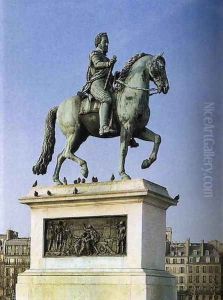Francois-Frederic Lemot Paintings
François-Frédéric Lemot was a prominent French sculptor born in Lyon in 1771. His contributions to art during the late 18th and early 19th centuries were significant, reflecting the changing tastes and political climates of the time. Lemot was well-regarded for his exceptional skill in sculpting, which he honed under the tutelage of notable artists of the era. His works are characterized by a blend of classical tradition and the emerging Romantic sensibilities that would come to define the period.
Lemot's career was markedly influenced by the tumultuous events of his time, including the French Revolution and the Napoleonic Wars. Despite these challenges, he managed to secure commissions that would cement his reputation as one of the leading sculptors of his generation. Among his most famous works are statues and busts of key figures of the French Revolution and the Napoleonic era, as well as decorative sculptures for public spaces and private patrons.
One of Lemot's major contributions was his involvement in the restoration and decoration of several important public buildings and monuments in France. This not only showcased his artistic talents but also his ability to work on a grand scale, contributing to the beautification and historical preservation of French heritage sites. His work during this period reflects a deep respect for classical forms, while also incorporating elements that were distinctly modern for his time.
François-Frédéric Lemot passed away in 1827, leaving behind a legacy that would influence future generations of sculptors. His ability to navigate the complex socio-political landscape of his era, while maintaining a high standard of artistic excellence, makes him a fascinating figure in the history of French art. Today, his works can be found in museums, galleries, and public spaces, continuing to inspire admiration and scholarly interest.
